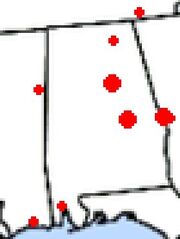Prior to Doomsday, Alabama was one of the states in the Southern United States.
History[]
Pre-Doomsday[]
From the American Civil War until World War II, Alabama, like many Southern states, suffered economic hardship, in part because of continued dependence on agriculture. Despite the growth of major industries and urban centers, white rural interests dominated the state legislature until the 1960s, while urban interests and African Americans were under-represented. Following World War II, Alabama experienced growth as the economy of the state transitioned from agriculture to diversified interests in heavy manufacturing, mineral extraction, education, and technology. In addition, the establishment or expansion of multiple military installations, primarily those of the U.S. Army and U.S. Air Force, added to state jobs.
Post-Doomsday[]
On September 25, 1983, the industrial, educational political centers of Alabama were struck with varying severity by soviet nuclear weapons. As the emergency broadcasting system went into effect, evacuations of the cities proved to be almost impossible due to both the suddenness of the attack and the lack of contingency plans in effect at the the time. The state government, or at least the most important staff, was evacuated to the countryside, eventually gathering in Auburn, a college town on the edge of the kill zone surrounding Columbus, Georgia. The city became the provisional capital even as refugees streamed in from Birmingham and Montgomery. Shielded military communications had put out a call for soldiers and guardsmen to come to the city as soon a possible.
The Fall of Auburn[]
Although much of the government survived, the situation in Auburn turned out to be disastrous. A civil war between the forces of Governor Wallace and the Klan-led state police brought about the near destruction of Auburn and nearby Tuskegee. After the assassination of Gov. Wallace, Lt. Gov. Baxley and a few other officials escaped to south Georgia, while the rebels went on to cause havoc in Selma before eventually forming their own government in New Montgomery.
Known Hits[]

Nuclear Strikes in Alabama
When the World Census and Reclamation Bureau (WCRB) surveyed the area, based on flyovers by the Mexican Air Force and original records from the Juneau Bureau of the Associated Press, just four cities - Birmingham, Huntsville, Mobile, Montgomery and Phenix City - were destroyed. However, two of these cities contained the bulk of the population of the state, and another was the seat of the government.
Birmingham was the state's largest city and a manufacturing hub. Huntsville, historically important in the US space program, had still been the home to a large scientific community involved in the aerospace program. Mobile, another large city, was the main port on Alabama's small coastline. Montgomery was the state's capital city (and historically the first capital of the Confederate States of America). Much smaller Phenix City was destroyed because of its proximity to Columbus, Georgia, and nearby Fort Benning.
Known Survivor Communities[]
There are three known survivor communities in the state, two resulting from the fall of Tuscaloosa and Auburn -- Selma and New Montgomery -- and one that claims to be the successor of the former US state. The state, going by the name of Alabama, has its capital in Florence and was a member state of a revived Confederate States of America until 1999 when that nation dissolved. This state, comprised of several counties in the northern part of historical Alabama, is active in international politics with former CSA and states adjacent to those states.
| ||||||||||

